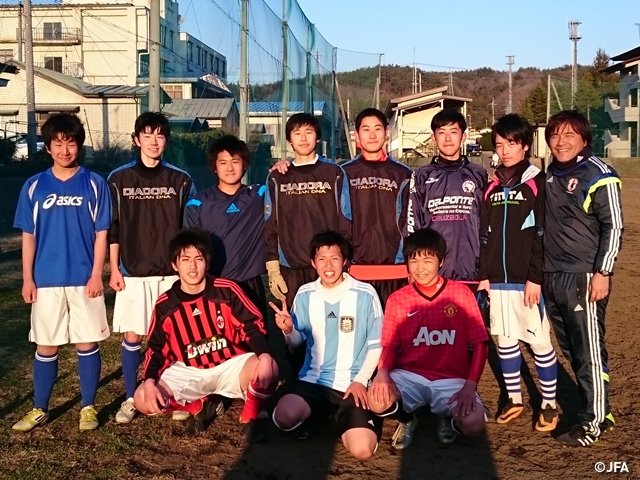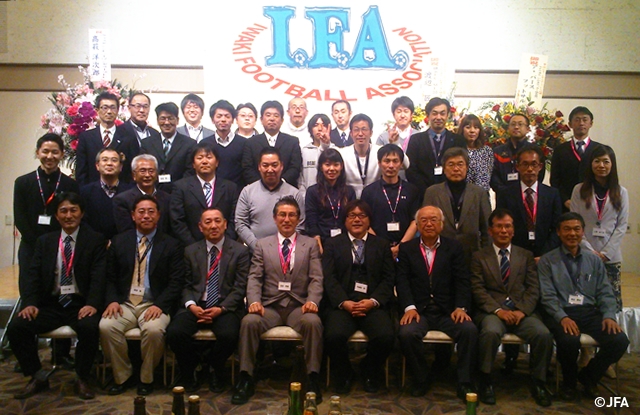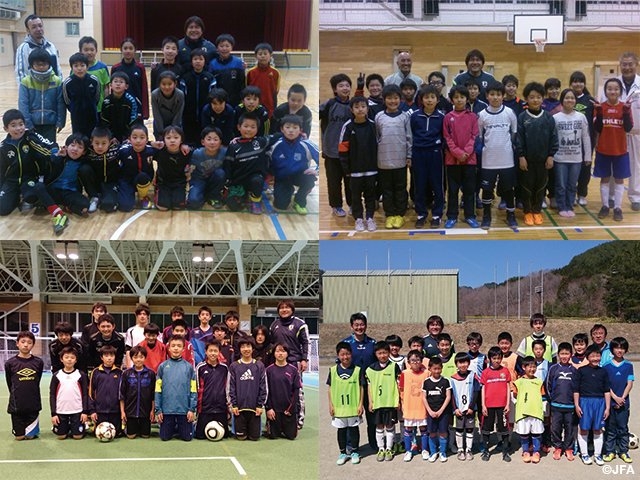NEWS
JFA Tohoku Reconstruction Support Project - March 2015 Report by TEGURAMORI Hiroshi, national training centre coach
08 April 2015

On 12 March, I paid a visit to a training site of Watanoha Soccer Sports Shonendan (Boys Sports Club) based in Ishinomaki, Miyagi. The Shonendan team usually practice at the field of Mangokuura Elementary School. The school’s gym was broken down by Tsunami when the earthquake disaster occurred. After that, it was rebuilt and has been available since last October. The field was being used by other sports organisations as well, but those coaches were also pleased that they now can practice at the restored gym when raining or during a winter season when it gets dark earlier in the evening.
In the training with a new roster after sixth-graders graduated, they worked on repetitive fundamental drills and 3v1 possession drills. At the end, the players had a scrimmage and I also played together. It was the first time for some of the children to play football, but everyone was so willing to chase the ball.
In Ishinomaki District, there are still a lot of teams who train at a gym, and they have hard time using it in this period when graduation and entrance ceremonies take place and occupy the gyms. Although they are still waiting for improvement on playing fields, they still say their sports activity has greatly made progress after the gym’s recovery.
On 14th, I attended “the 2nd Iwaki Football Conference,” held at Spa Resort Hawaiians’ Lapita in Iwaki, Fukushima. The conference had presentations including the activity report by NPO Iwaki Football Association, the reports of each category’s tournaments and by training centres and a dietary education seminar as well. I also spoke on “philosophy on player development in league tournaments.” In the get-together party after the conference, I had good discussions with NPO Iwaki Football Association Chairman HANADA Kunishiro and other coaches on player development, the league tournament system. Two of NPO Dream Soccer Soma staff and staff from other districts also took part in the party. Fukushima people are apparently enthusiastic about football and highly conscious on player development.

On 17th and 18th, I went to Otsuchi in Iwate. Otsuchi SC players were divided into two groups and had training separately. Second and third graders trained at Kinrosha Gymnasium and fourth and fifth graders trained at the gym of Otsuchi Town Hall. I joined practice of fourth and fifth graders. We worked on fundamentals first and then went through defensive drills and man-to-man-with-goalkeeper drills. The children aggressively gave it a try in the limited time.
There are joint makeshift school buildings for elementary and junior high schools in Terano District, Otsuchi. In the near future, they are to move to the field of Otsuchi High School in Sawayama District and become an integrated elementary-junior high school, which is now being built on the site. The field of Otsuchi High School is the only place where the field is big enough for one football pitch.
Club activities of junior high school and high school are currently held at the makeshift field next to Kirari Fukko Shoten in Hokusho District, but another makeshift multipurpose field is under construction in Sakae-machi. In 2019, a multipurpose field is scheduled to be rebuilt in Shinmachi, Akahama District. I heard the makeshift field in Sakae-machi will be removed after its completion of Shinmachi one. I believe they could keep the field, though.
On 18th, I headed to Ofunato’s Civic Gymnasium, where Ofunato Sanriku Seagull practice was being held. Their practice starting at 5 p.m. included tag games, pass and control drills, man-to-man drills and a scrimmage. The children worked hard for two hours. In the get-together party with coaches after the practice, I learned the situation of temporary houses and training environments of Class 2 (high school) and Class 3 (junior high school).
At Ofunato Port, seawalls building and ground levelling have been under way, but I was told that they would take more time to be completed while people are still waiting for their reconstruction public housing.
On 26th, I observed Iwaizumi High School football club’s training from 3 p.m. They tried to learn the importance of fundamental in passing drills and decision making in possession drills. At the end, the players worked on s+3v3+goalkeeper drill in front of goal. They seemed very vigorous, and the two hours passed instantly.
I visited Greenpia Sanriku Miyako’s multipurpose arena at 6:00 p.m. and joined training of Derufire Taro. I coached defence to former Derufire Taro players. Those former DF Taro players who currently belong to Taro-Daiichi Junior High School have the limited time of practicing at their school. The amount of practicing time is simply short because they need to use school bus. They join practice of the Sports Shonendan to get more practicing time.
On 28th, I went to a sports park in Yamaya, Osawa, Yamada and participated in Yamada Berueni’s training. They worked on coordination drills, dribbling and 3v3 with four goals and then finished with shooting drills. As the temperature went up to 20 degrees, children worked up sweat under enthusiastic coaching for two hours and half.
After the practice, Yamada Berueni’s manager KURAMOTO Shurou guided me to the rooftop of the town hall and I had the whole view of the town of Yamada. Yamada is “the place whose reconstruction has been most delayed” according to Mr. KURAMOTO Shurou and now the ground is being levelled. Once fills are completed, commercial facilities and residential sections are going to be built, so it takes more time for reconstruction.
In the town surrounded with seawalls, there is also a 9-meter seawall now being built. Before the construction began, no one claimed it would spoil the scenery. As it’s been four years since the disaster, more people have built their own house in an inland region or moved away to a rental house before the completion of the projected public housing. They can’t wait for the completion. And the number of children has declined. Due to the disaster in addition to the falling birth rate already happening in this country, a lot of teams in this town are having difficulty surviving. And coaches are concerned about their future and said they need to consider how to cope with that in various ways such as merging teams.

Related News
-
2015/03/24
JFA Tohoku Reconstruction Support Project - February 2015 report by TEGURAMORI Hiroshi, national training centre coach

-
2015/03/06
JFA Tohoku Reconstruction Support Project - January 2015 Report by TEGURAMORI Hiroshi, national training centre coach

-
2015/01/16
JFA Tohoku Reconstruction Support Project - December 2014 Report by TEGURAMORI Hiroshi, national training centre coach

Latest News
-
National Teams
2025/12/15
Japan Beach Soccer National Team squad & schedule - Training Camp (12/17-20@Okinawa)

-
National Teams
2025/12/15
U-22 Japan National Team squad & schedule - IBARAKI Next Generation Cup 2025 (12/21-27@K's denki Stadium Mito, Ibaraki)

-
National Teams
2025/12/12
U-18 Japan National Team squad & schedule - SBS CUP INTERNATIONAL Youth Soccer 2025 (12/15-21@Shizuoka)

-
National Teams
2025/12/10
U-15 Japan National Team squad & schedule - EAFF U-15 Championship 2025 (12/16-23@Fujian, China PR)

-
National Teams
2025/12/09
Japan Futsal National Team squad & schedule - FUTSAL WEEK December Cup (12/14-23@Porec, Croatia)



